생후 8~9개월 영아들의 성장 발육, Growth and development of 8~9 month old infants
표 3-4.생후 8개월 된 한국 영아들의 체중과 신장의 백분위수
|
백분위수
성별 |
3 | 10 | 25 | 50 | 75 | 90 | 97 | |
| 남아 | 체중(kg) | 7.0 | 7.30 | 8.00 | 8.50 | 9.20 | 9.75 | 10.70 |
| 신장(cm) | 64.4 | 66.5 | 68.5 | 70.4 | 72.4 | 74.6 | 80.6 | |
| 여아 | 체중(kg) | 6.45 | 6.95 | 7.40 | 8.00 | 8.70 | 9.50 | 10.50 |
| 신장(cm) | 62.3 | 65.0 | 67.0 | 69.0 | 71.0 | 73.0 | 78.7 |
표 3-5. 9개월 한국 영아들의 체중과 신장의 백분위수
|
백분위수
성별 |
3 | 10 | 25 | 50 | 75 | 90 | 97 | |
| 남아 | 체중(kg) | 7.01 | 7.60 | 8.10 | 8.70 | 9.40 | 10.00 | 10.75 |
| 신장(cm) | 65.0 | 67.8 | 69.3 | 71.4 | 73.0 | 75.0 | 78.3 | |
| 여아 | 체중(kg) | 6.50 | 7.05 | 7.70 | 8.22 | 8.90 | 9.60 | 10.86 |
| 신장(cm) | 64.0 | 66.8 | 68.2 | 70.0 | 72.0 | 74.0 | 82.4 |
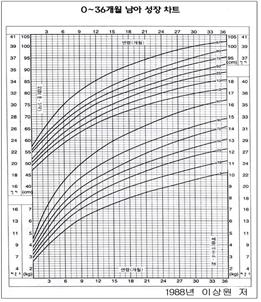
그림 3-88. 0-36개월. 생후 0~36개월 된 한국 남 신생아들과 남 영유아들의 성장차트와 백분위수.
Copyright ⓒ 2012 John Sangwon Lee, MD., FAAP
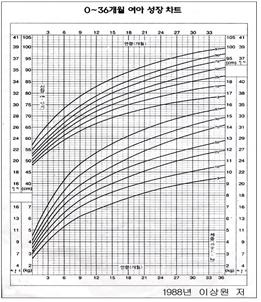
그림 3-89. 생후 0~36개월 된 한국 여 신생아들과 여 영유아들의 성장차트와 백분위수.
Copyright ⓒ 2012 John Sangwon Lee, MD ., FAAP
- 생후 9개월에 정기 건강검진을 받고 체중과 신장을 잰다.
- 잰 체중 치와 신장 치를 성장차트 체중·신장 백분위선에 그린다. 체중과 신장이 성장차트 백분위선 상 어디에 있는지 알아본다.
- 체중과 신장이 그의 성장차트 체중·신장 백분위선을 따라 이전과 거의 같게 계속 증가하면서 정상적으로 자라는지 알아본다.
- 생후 7~8개월경부터 대부분의 영아들은 생후 7~8개월 이전 체중 백분위선을 따라 계속 늘지 않고 그 동안의 체중 백분위선보다 조금 아래에 있는 체중 백분위선을 따라 증가하는 경우가 많다. 물론 조금 위에 있는 백분위선을 따라 증가하는 경우도 드물게 있다.
- 대부분의 8~9개월 영아들은 전보다 잠을 덜 자고 스스로 육체적 활동을 더 많이 하고 더 활동적이다.
- 육체적 활동으로 에너지를 전보다 더 많이 소모한다.
- 생후 8~9개월 이전 영아들의 대부분은 엄마 아빠가 먹여주는 대로 음식물을 순순히 조건 없이 받아먹었지만, 이제 부터는 엄마 아빠가 먹여 주는 대로 음식물을 먹지 않는 것이 보통이다.
- 영아 자신이 좋아하는 음식물을 골라 먹는 선택권을 행사하는 것이 보통이다.
- 생후 7~8개월 이후부터 대부분의 영아들의 체중 증가 속도가 이전의 체중 증가 속도보다 느리다.
- 그렇지만 체중은 서서히 계속 증가된다.
- 이 시기부터 사춘기가 시작하기 바로 전까지 대부분의 영아들의 체중 증가 속도는 느린 것이 정상이다.
| 생후 8~9개월 영아들의 발육 |
Development of 8~9-month-old infants
1. 생후 8~9개월 영아들의 신체 발육
- 이 시기의 영아들은 잠시 잠깐 한 자리에 가만히 있지 않고 이곳저곳으로 잘 기어 다니는 것이 보통이다.
- 높은 곳이나 위험한 곳에서 혼자 놀게 해서는 안 된다.
- 이 나이 영아들의 대부분은 앉을 때 등을 전보다 더 곧게 편다.
- 몸통, 팔, 다리 등이 전보다 더 조화롭게 움직일 수 있다.
- 앉아 있는 자세에서 몸통을 앞으로 더 쉽게 굽힐 수 있다.
- 이 시기 영아들의 대부분은 혼자서 서고 걷는 것을 배우기 시작한다.
- 영아들의 일부는 혼자 설 수 있고 걸을 수 있고 일부는 엄마 아빠의 손을 잡고 걸음마를 배우기 시작한다.
- 소파나 의자 등 가구를 붙들고 걷는 영아도 있고 붙들지 않고 혼자서 잘 걸을 수 있는 일부 영아도 있고 이방 저 방을 기어 다니는 영아도 있다.
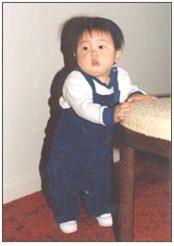
사진 3-90. 8개월 된 영아들의 80%는 소파 등 가구를 붙들고 혼자서 설 수 있다.
Copyright ⓒ 2012 John Sangwon Lee, MD., FAAP
2. 생후 8~9개월 영아들의 손 발육
- 엄지와 집게손가락으로 작은 장난감을 집을 수 있다.
- 두 개의 장난감을 합치는 장난을 좋아한다.
- 작은 장난감을 컵 속이나 통 속에 집어넣다 꺼냈다 하는 장난도 할 수 있다.
3. 생후 8~9개월 영아들의 언어 발육
- 생후 8~9개월 된 영아들의 대부분은 ‘마마’ 또는 ‘다다’ 등 말을 하기 시작한다.
4. 생후 8~9개월 영아들의 사회성 발육
- 엄마 아빠 앞에서 기어왔다 기어갔다 하면서 놀 수 있고 짝짜꿍 등 손 놀이를 하기 좋아한다.
- ‘아냐.’ 또는 ‘안 돼.’ 등의 말을 알아듣기 시작한다.
- 자기 이름을 불으면 자기를 부르는지 알고 몸짓 말로 반응할 수 있다.
- 엄마 아빠나 친밀한 사람이 두 손을 뻗치면서 오라고 하면 그 사람에게 갈 수 있다.
- 분리공포가 생기기 시작한다. 그로 인해 밤에 혼자 자기 싫어한다.
- 어둘 때 무서워하고 동물을 무서워하고 혼자 자기 싫어한다(p.00 “생후 1개월~6세의 영유아들의 발육 이정표”).
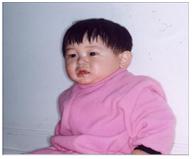
사진 3-91. 9개월 된 영아들의 일부는 혼자서 잘 앉을 수 있다.
Copyright ⓒ 2012 John Sangwon Lee, MD., FAAP

사진 3-92. 생후 8~9개월 된 영아들은 잠시잠깐 가만히 있지 않고 여기저기 기어 다니는 것이 보통이다.
Copyright ⓒ 2012 John Sangwon Lee, MD., FAAP
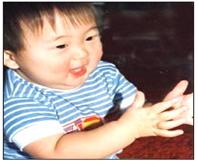
사진 3-93. 생후 9개월 경 영아들은 짝짜꿍을 할 수 있다.
Copyright ⓒ 2012 John Sangwon Lee, MD., FAAP
| 생후 8~9개월 영아들의 장난감 |
Toys for 8~9 month infants
장난감 참조
| 생후 8~9개월 영아들의 영양 |
1. 모유 수유
- 이 시기 대부분의 영아들은 엄마 아빠나 다른 식구들이 먹는 밥상 음식물을 먹기 좋아한다.
- 모유수유는 전과 같이 계속해도 되지만 젖도 먹이고 이유식도 먹이고 인공영양도 먹일 수 있다.
- 또 영아에게 먹기 좋게 따로 요리한 영아 음식물(주니어)을 영아에게 먹일 수 있다.
- 유치가 충분히 나 있지 않으므로 씹어야 먹을 수 있는 이유식은 영아에게 먹여서는 안 된다.
- 이유식, 인공영양, 또는 영아용 밥상 음식물을 잘 먹을 수 있고 먹은 후 이상 없고, 잘 소화시킬 수 있고 정상적으로 성장 발육하면 모유수유를 더 이상 하지 말고 이유해도 된다.
- 영아들 스스로 숟가락으로, 손으로, 또는 이유 연습용 컵으로 이유식을 먹을 수 있다.
- 주스류 이유식이나 그 외 액체 이유식은 이유 연습용 컵으로 먹도록 한다([부모도 반의사가 되어야 한다-소아가정간호 백과]-제 22권 아들 딸 이렇게 키우시오-영아 이유식, 이유식이란, 이유식을 줄 수 있는 아기의 나이 참조).
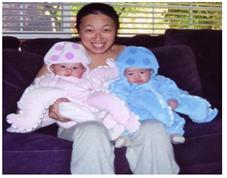
사진 3-94. 혼합수유도 않고 쌍둥이 남매를 모유수유로만 생후 6~7개월까지 잘 키웠다. 쌍둥이 아기들과 그들의 부모들 모임(쌍둥이 클럽)을 통해 쌍둥이를 키우는 법을 배우면서 그들을 양육한다.
Copyright ⓒ 2012 John Sangwon Lee, MD., FAAP
2. 인공영양
- 인공영양을 1회분 150~240cc 정도를 1일 4~6번 정도 먹인다.
- 엄마 아빠나 집안 식구들이 먹는 밥상 음식물, 시리얼류 이유식, 육류 이유식, 과일류 주스 이유식, 과일 소스 이유식, 야채즙류 이유식, 야채류 주스 이유식, 야채류 이유식과 인공영양을 영아들에게 골고루 균형 잡히게 먹일 수 있다.
3. 이유식

사진 3-95. 생후 7~8개월 된 영아들의 대부분은 영아 이유식 과자를 혼자서 손으로 붙잡고 잘 먹을 수 있다. Copyright ⓒ 2012 John Sangwon Lee, MD ., FAAP
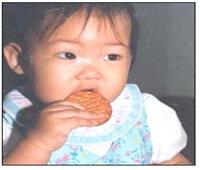
사진 3-96. 생후 7~8개월 된 영아들의 대부분은 영아 이유식 과자를 이렇게 손으로 붙잡고 잘 먹을 수 있다. Copyright ⓒ 2012 John Sangwon Lee, MD ., FAAP
- 영아 이유식의 종류, 양, 먹이는 시간과 순서를 일률적으로 정할 수 없다.
- 모유나 인공영양을 먹이기 바로 전 영아가 좋아하는 이유식을 먹인 후 모유나 인공영양을 먹일 수 있다.
- 모유나 인공영양을 먹이는 대신 이유식만 먹일 수 있고, 인공영양이나 모유를 먹인 바로 후 이유식을 먹일 수 있다.
- 엄마 아빠나 다른 식구들이 먹는 밥상 위 보통 음식물과 각종 이유식을 잘 먹고 잘 소화시키고 정상적으로 성장 발육을 잘하면 모유나 인공영양을 첫돌이 될 때까지 계속 먹일 수 있다.
- 엄마 아빠가 먹는 음식물과 이유식만 먹여도 되지만 모유수유를 계속 하고 싶으면 모유수유를 해도 된다.
- 엄마 아빠가 먹는 보통 밥상 음식물을 먹일 때 사레들리지 않게 주의하고 질식되지 않게 영아에게 알맞게 요리해서 먹여야 한다.
4. 물과 수분
- 모유나 인공영양 이 외 음식물-이유식이나 밥상 음식물을 먹을 때는 맹물을 가끔 먹여야 한다.
- 특히 여름철이나 더울 때는 맹물을 더 자주 먹여야 한다.
5. 비타민제와 철분제, 불소제
- 모유, 인공영양, 이유식, 밥상 음식물을 균형 잡히게 먹는 영아들에게 비타민제나 철분제를 가외로 꼭 먹일 필요 없다.
- 편식 하는 영아들은 먹는 음식물에서 필요한 비타민과 철분을 충분히 섭취하지 못할 수 있다. 그 런 경우나, 매일 먹는 음식물에서 철분, 불소 또는 비타민을 충분히 섭취 못한다고 생각하면 의사와 상의해서 철분과 불소가 든 종합 비타민제를 매일 섭취하든지 또는 하루 이틀 걸러 먹일 수 있다.
| 생후 8~9개월 영아들의 양호 |
- 생후 9개월 경 정기 건강검진을 받는다.
- 빈혈이 있나 알아보기 위해 빈혈검사(헤모글로빈 검사 또는 헤마토크리트 검사)를 하고
- 신장염이나 요로 감염 등이 있나 알아보기 위해 소변검사를 한다.
Growth and development of 8-9-month-old infants
Table 3-4. Percentiles of weight and height of 8-month-old Korean infants percentile
표 3-4.생후 8개월 된 한국 영아들의 체중과 신장의 백분위수
|
Percentile
Gender |
3 | 10 | 25 | 50 | 75 | 90 | 97 | |
| boy | 체중(kg)
Weight (kg) |
7.0 | 7.30 | 8.00 | 8.50 | 9.20 | 9.75 | 10.70 |
| 신장(cm)
Height (cm) |
64.4 | 66.5 | 68.5 | 70.4 | 72.4 | 74.6 | 80.6 | |
| girl | 체중(kg)
Weight (kg)
|
6.45 | 6.95 | 7.40 | 8.00 | 8.70 | 9.50 | 10.50 |
| 신장(cm)
Height (cm) |
62.3 | 65.0 | 67.0 | 69.0 | 71.0 | 73.0 | 78.7 |
Table 3-5. Percentiles of weight and height of 9-month-old Korean infants 표 3-5. 9개월 한국 영아들의 체중과 신장의 백분위수
|
Percentile
Gender |
3 | 10 | 25 | 50 | 75 | 90 | 97 | |
| boy | 체중(kg) Weight (kg) |
7.01 | 7.60 | 8.10 | 8.70 | 9.40 | 10.00 | 10.75 |
| 신장(cm)
Height (cm) |
65.0 | 67.8 | 69.3 | 71.4 | 73.0 | 75.0 | 78.3 | |
| girl | 체중(kg)
Weight (kg)
|
6.50 | 7.05 | 7.70 | 8.22 | 8.90 | 9.60 | 10.86 |
| 신장(cm)
Height (cm) |
64.0 | 66.8 | 68.2 | 70.0 | 72.0 | 74.0 | 82.4 |

Figure 3-88. 0-36 months. Growth charts and percentiles of Korean male newborns and male infants aged 0 to 36 months of age. Copyright ⓒ 2012 John Sangwon Lee, MD., FAAP

Figure 3-89. Growth charts and percentiles of Korean newborn female infants and female infants aged 0 to 36 months of age. Copyright ⓒ 2012 John Sangwon Lee, MD ., FAAP
• Get regular health checkups at 9 months of age and measure their weight and height.
• Draw the measured weight and height values on the weight and height percentiles of the growth chart. Find out where their weight and height are on the percentiles of the growth chart.
• Check if their weight and height continue to increase normally along with the weight and height percentiles of their growth chart, almost the same as before.
• From around 7-8 months of age, most infants do not continue to increase along with the weight percentile before 7-8 months of age, but increase along with the weight percentile that is slightly below the previous weight percentile. Of course, there are rare cases where it increases along with a percentile that is slightly above.
• Most 8-9-month-olds sleep less and are more physically active and more active on their own than before.
• Physical activity consumes more energy than ever before.
• Most infants before 8 to 9 months of age accepted food as their mother and father fed them without any conditions, but from now on, it is common not to eat food as their mother or father feeds them.
• It is common for infants to exercise the right to choose and eat their own favorite foods.
• After 7-8 months of age, most infants gain weight slower than before.
• However, the weight continues to increase slowly.
• From this period until just before the onset of puberty, it is normal for most infants to gain weight slowly.
Development of 8-9-month-old infants
1. Physical development of infants aged 8 to 9 months
• It is normal for infants at this age to crawl from place to place rather than sitting still for a while.
• Do not let them play alone in high places or in dangerous places.
• Most infants at this age have their backs straighter than before when sitting.
• The torso, arms and legs can move more harmoniously than before.
• They can more easily bend their torso forward in a sitting position.
• At this age, most infants begin to learn to stand and walk on their own.
• Some infants can stand and walk on their own, and some begin to learn to walk holding their mom and dad’s hands.
• Some infants walk holding on to furniture, such as sofas or chairs, some infants can walk alone without holding on to them, and some infants crawl from room to room.

Picture 3-90. 80% of 8-month-old infants can stand on their own, holding on to furniture, such as a sofa. Copyright ⓒ 2012 John Sangwon Lee, MD., FAAP
2. Hand development of 8-9-month-old infants
• They can pick up small toys with their thumb and forefinger.
• Likes to play with two toys.
• They can even play with small toys, putting them in a cup or a bucket and taking them out.
3. Language development of 8-9-month-old infants
• Most infants aged 8-9 months begin to say ‘mama’ or ‘dada’.
4. Social development of 8-9-month-old infants
• They can crawl in front of Mom and Dad, and they like to play with their hands, such as clapping hands.
• ‘No.’ or ‘No.’ they start to hear things like that.
• When you say his name, he knows you are calling, and he can respond with body language.
• If Mom, Dad, or someone close to him reaches out and asks him to come, he can go to that person.
• Separation fear begins to develop. Because of this, they hate sleeping alone at night.
• Afraid of the dark, afraid of animals, and dislike of sleeping alone (p.00 “Milestones in the development of infants 1 month to 6 years old”).

Picture 3-91. Some 9-month-old infants can sit well on their own. Copyright ⓒ 2012 John Sangwon Lee, MD., FAAP

Picture 3-92. It is common for infants aged 8-9 months to crawl around without being still for a while. Copyright ⓒ 2012 John Sangwon Lee, MD., FAAP

Picture 3-93. Around 9 months of age, infants are able to play peek-a-boo. Copyright ⓒ 2012 John Sangwon Lee, MD., FAAP
Toys for babies 8-9 months old
Toys for 8-9 month infants toy reference
Nutrition for infants aged 8-9 months
1. Breastfeeding
• Most infants at this age like to eat food from their mother’s and father’s and other family members’ tables.
• Breastfeeding can be continued as before, but breastfeeding, baby food, and artificial nutrition can be given.
• You can also feed infant food (junior) cooked separately for infants.
• Chewable baby food should not be fed to infants because they do not have enough baby teeth.
• If they can eat baby food, artificial nutrition, or baby food, there is no problem after eating, they can digest it well, and they grow and develop normally, they can wean without breastfeeding any more.
• Infants can feed themselves with a spoon, by hand, or from a weaning cup.
• Juice baby food or other liquid baby food should be eaten with a weaning practice cup. www.drleepediatrics.com – Encyclopedia of Pediatric and Family Nursing]-Vol. See the age of the baby with

Picture 3-94. She raised her twins well from 6 to 7 months of age only by breastfeeding without mixed feeding. Raising twin babies and their parents by learning how to raise twins through a group (twin club). Copyright ⓒ 2012 John Sangwon Lee, MD., FAAP
2. Artificial nutrition
• Feed about 150~240cc of artificial nutrition 4~6 times a day.
• Infants can be fed in a balanced way with food from mother, father or family members, cereal baby food, meat baby food, fruit juice baby food, fruit sauce baby food, vegetable juice baby food, vegetable juice baby food, vegetable baby food and artificial nutrition.
3. Weaning Baby food

Picture 3-95. Most of the 7-8-month-old infants can hold baby food snacks by themselves and eat them well. Copyright ⓒ 2012 John Sangwon Lee, MD ., FAAP

Picture 3-96. Most of the 7-8-month-old infants can hold baby food cookies like this with their hands and eat them well. Copyright ⓒ 2012 John Sangwon Lee, MD ., FAAP
• The type, amount, feeding time, and order of baby food cannot be uniformly determined.
• Breast milk or artificial nutrition can be fed after feeding the infant’s favorite baby food just before breast milk or artificial nutrition.
• Instead of feeding with breast milk or artificial nutrition, only baby food can be fed, and baby food can be fed immediately after feeding with artificial nutrition or breast milk.
• If mothers, fathers and other family members eat and digest well-balanced foods and various baby foods on the table they eat, breast milk or artificial nutrition can be continued until they reach their first birthday.
• You can feed only the food and baby food that mom and dad eat, but if you want to continue breastfeeding, you can breastfeed.
• When feeding the food from the normal table that mom and dad eat, be careful not to become stale and cook properly so as not to choke and feed it to the infant.
4. Water and Moisture
• Food other than breast milk or artificial nutrition – When eating baby food or table food, freshwater should be given occasionally.
• Freshwater should be fed more often, especially in summer or when it is hot.
5. Vitamins, iron, and fluoride
• Infants who eat breast milk, artificial nutrition, baby food, and table food in a balanced way do not necessarily need extra vitamins or iron supplements.
• Infants who are picky eaters may not be getting enough of the vitamins and iron they need from the diet they eat. In that case, or if you think they are not getting enough iron, fluoride, or vitamins from their daily diet, you can consult with your doctor to take a daily multivitamin containing iron and fluoride, or every other day or two.
Good care and parenting for 8-9 months old infants
• Receive regular health checkups around 9 months of age.
• Do an anemia test (hemoglobin test or hematocrit test) to see if you have anemia.
• A urine test to check for nephritis or a urinary tract infection.
출처 및 참조문헌
- Nelson Textbook of Pediatrics 22ND Ed
- The Harriet Lane Handbook 22ND Ed
- Growth and development of the children
- www.drleepediatrics.com 제1권 소아청소년 응급 의료
- www.drleepediatrics.com 제2권 소아청소년 예방
- www.drleepediatrics.com 제3권 소아청소년 성장 발육 육아
- www.drleepediatrics.com 제4권 모유,모유수유, 이유
- www.drleepediatrics.com 제5권 인공영양, 우유, 이유식, 비타민, 미네랄, 단백질, 탄수화물, 지방
- www.drleepediatrics.com 제6권 신생아 성장 발육 육아 질병
- www.drleepediatrics.com제7권 소아청소년 감염병
- www.drleepediatrics.com제8권 소아청소년 호흡기 질환
- www.drleepediatrics.com제9권 소아청소년 소화기 질환
- www.drleepediatrics.com제10권. 소아청소년 신장 비뇨 생식기 질환
- www.drleepediatrics.com제11권. 소아청소년 심장 혈관계 질환
- www.drleepediatrics.com제12권. 소아청소년 신경 정신 질환, 행동 수면 문제
- www.drleepediatrics.com제13권. 소아청소년 혈액, 림프, 종양 질환
- www.drleepediatrics.com제14권. 소아청소년 내분비, 유전, 염색체, 대사, 희귀병
- www.drleepediatrics.com제15권. 소아청소년 알레르기, 자가 면역질환
- www.drleepediatrics.com제16권. 소아청소년 정형외과 질환
- www.drleepediatrics.com제17권. 소아청소년 피부 질환
- www.drleepediatrics.com제18권. 소아청소년 이비인후(귀 코 인두 후두) 질환
- www.drleepediatrics.com제19권. 소아청소년 안과 (눈)질환
- www.drleepediatrics.com 제20권 소아청소년 이 (치아)질환
- www.drleepediatrics.com 제21권 소아청소년 가정 학교 간호
- www.drleepediatrics.com 제22권 아들 딸 이렇게 사랑해 키우세요
- www.drleepediatrics.com 제23권 사춘기 아이들의 성장 발육 질병
- www.drleepediatrics.com 제24권 소아청소년 성교육
- www.drleepediatrics.com 제25권 임신, 분만, 출산, 신생아 돌보기
- Red book 29th-31st edition 2021
- Nelson Text Book of Pediatrics 19th- 21st Edition
- The Johns Hopkins Hospital, The Harriet Lane Handbook, 22nd edition
- 응급환자관리 정담미디어
-
소아가정간호백과–부모도 반의사가 되어야 한다, 이상원
-
Neonatal Resuscitation American heart Association
-
Neonatology Jeffrey J.Pomerance, C. Joan Richardson
-
Pediatric Resuscitation Pediatric Clinics of North America, Stephen M. Schexnayder, M.D.
-
Pediatric Critical Care, Pediatric Clinics of North America, James P. Orlowski, M.D.
-
Preparation for Birth. Beverly Savage and Dianna Smith
-
Infectious disease of children, Saul Krugman, Samuel L Katz, Ann A. Gershon, Catherine Wilfert
- 소아과학 대한교과서
- Growth and Development of Children, Eighth Edition, George H. Lowrey, Yearbook Medical Publishers
- Growth and Development of Children, Fifth Edition, E. H. Watson and G. H. Lowrey, Yearbook Medical Publishers
- Other
-
Copyright ⓒ 2015 John Sangwon Lee, MD., FAAP
미국 소아과 전문의, 한국 소아청소년과 전문의 이상원 저 “부모도 반의사가 되어야 한다”-내용은 여러분들의 의사로부터 얻은 정보와 진료를 대신할 수 없습니다.
“The information contained in this publication should not be used as a substitute for the medical care and advice of your doctor. There may be variations in treatment that your doctor may recommend based on individual facts and circumstances. “Parental education is the best medicine.”